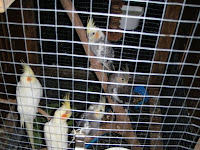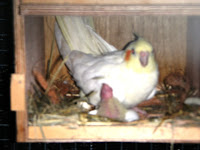Ni ada sedikit info yang aku dapat dari web cara-cara menentukan jantina cockatiel. Boleh la usha-2 ye sebagai panduan supaya tak salah pilih. Bagi aku setakat sekarang aku pastikan jantina dengan warna tompok merah (patches) pada pipi, yang terang jantan dan pudar betina atau warna muka yang boleh dikatakan 90% kuning dan betina selalunya kurang. Kalau dua cara ni gagal baru aku tunggu dia bersiul dan selalu yang betina tidak berlagu, seperti menjerit tapi jantan lebih banyak melodi atau bunyi. Tapi kalau white face atau albino aku memang fail untuk membezakan jantan dan betina, kena ikut kata Tan Sri P.Ramlee kot "Kalau si jantan nampak si betina, apa dibuatnye?? Dikejarnya lah.....". Boleh refer pada otai-2 atau pakar-2 burung sebab aku ni pon baru sehari jagung je ilmu pasal burung ni.
=======================================================




The below feature some of the available cockatiel mutations and sexing information is also provided whenever available. However, keep in mind that immature birds look alike and it is difficult to sex cockatiels until they have been through their first molt and the adult coloring shows, which usually occurs when they are six to nine months of age. Other than the visual sexing that can be performed on mature birds, some breeders also check the pelvic bones as means of sexing a bird. The basic idea is that the pelvic of female cockatiels are more flexible and further apart -- as the egg has to be able to pass through it. It is actually pretty similar to the difference seen in human males and females.. Women usually have wider pelvic bones than males. This applies to cockatiels as well. However, just as is the case with humans, females can have "boyish" figures with narrow hips; and some males have wider hips. This also applies to cockatiels. Additionally, immature birds have wider pelvic bones. This all makes this method of sexing "iffy" at best. A lot of the excitement for cockatiel breeding can be explained by the many beautiful mutations that have occurred over the years. Starting with the normal grey, then pieds, cinnamons, lutinos and pearlies have resulted from matings. Later on white-faces, silvers and albinos have stirred up excitement in aviculture. Recently an orange-crested cock with the orange cheek patch extending into the face and crest has occurred. Breeders are waiting to see what mutation will pop up next, which explains the enthusiasm and joy they get from their hobby of breeding cockatiels.
Personality Differences:
Males tend to be more vocal than females, whistling more than their female counterparts.
Males tend to strut around - they lift their wings slightly, stick their chest out and parade and strut, normally calling at he same time.
Females are usually pretty quiet and are more likely to hiss and bite
Visual Differences:
Normal Grey
The Normal Grey is the original bird native to Australia. The male Normal Grey has grey feathers over his entire body, with the exception of the white wing bars, yellow face and bright orange cheek patches. Both sexes have those broad white bars along the edge of each wing. Females and young cockatiels (before 1st molt) have dull orange cheek patches; their faces are not bright yellow, but more grey with some yellowish infusion. The tail feathers have a white or yellow barring on the underside. If your normal grey cockatiel has a few white or yellow feathers on the back of his or her neck and head, your cockatiel is split to the recessive mutation Pied.
Lutino / Pied, Pearly Cockatiels
Lutinos: The Lutino is a yellow-white bird with orange cheek patches and red eyes - unless they are pied -like the one to the right is as you can see a little grey patch on his/her shoulder - which would make him a "light-pied as opposed to the normal pied, which will have heavy grey markings. In lutinos, baldness can occurs behind the crest. The bald spots were especially pronounced when the lutino mutation was first bred and in the following years after that. A lot if inbreeding of this mutation caused this undesirable bald patch, which doesn't diminish the tiel's pet quality - but is not a desired trait for breeding. Breeders have been working on reducing / eliminating the bold patch and have shown great success in doing so. It is very hard to distinguish mature cocks from hens. Although yellow barring on the underside of the tail are visible in females.
Lutino Pearl: The plumage is white with yellow pearling.
Pieds: This is a striking combination of yellow or white with light or dark grey. The amounts and placement of color vary widely. Even, symmetrical marking is desirable.
Pearly Pied: The colors are the same as the pied with the pearling only on portions of the wings. The bird is clear yellow or white, with areas of grey over the rest of the body.
Yellow-cheeks: Male birds have yellow faces with gold cheek patches.
Pastel. Male birds have yellow faces with peach cheek patches.
Cinnamon / Pearly / Fallows
Cinnamon: This mutation is similar to the normal with grey areas replaced by tan to cinnamon brown color.The Cinnamon mutation gets it name from the cinnamon color, which has been described as a brownish-grey color.
The male Cinnamon Cockatiel develops a bright yellow face (also know as the mask) and bright orange cheek patches after his first molt. Female Cinnamon cockatiels retain their dull orange cheek patches. Their faces do not turn yellow, and they have either white or yellow barring on the underside of their tails.
Cinnamon Pieds: The overall plumage is a combination of cinnamon brown and yellow, again varying in intensity of color and placement of markings.
Cinnamon Pearlies: The pearled feathers are yellow edged with the various shades of cinnamon.
Cinnamon Pearly Pieds: This mutation is similar to the pearly pieds with cinnamon brown over areas that would otherwise be grey.
Pearly: The "term" pearly refers to the lacings or pearl spots of yellow or white on the backs, nape, and wings. Yellow Pearls are sometimes called Golden Pearls. White pearling is sometimes called Silver Pearl. Pearling in a whiteface cockatiel is always white.The lacings should be extensive and consistent.
Females retain their pearly coloration into adulthood, while male lose their pearlings after their first molt (turning into a Pied cockatiel - rather than pearly pied). Fallows: The body color is a very pale cinnamon suffused with yellow, the face yellow and the eyes red.
Olives: Feathers have a green wash and a light spangling pattern.
Whitefaces / Albinos / Silvers
This beautiful whiteface mutation lacks the orange cheek patch and yellow pigmentation. Mature adult males have a white face as opposed to the yellow mask typical of the other varieties. Some of the more beautiful combinations include the Albino (all white), Pied Whiteface, Cinnamon Pied Pearly, Pearly Whiteface, and several others.
Albinos: Is pure white with no color what so ever. Eyes are red. In females, barring is visible on the underside of the tail .
Silver Mutation: The plumage is a light, silvery grey. The eyes are red.
Single-factor dominant silver. Feathers are a darker metallic silver, with orange check patches and black eyes, feet and beak (except in pieds, which have flesh-colored feet and beaks. A skullcap of darker pigmentation is visible on the head.
Double-factor dominate silver. Same as single-factor dominant silver, except feathers are a light metallic silver.
























